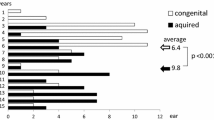Abstract
To document the clinical presentation, complications, management strategy and post-operative outcomes of extensive cholesteatomas. Cholesteatoma is a well demarcated cystic lesion derived from an abnormal growth of keratinizing squamous epithelium in the temporal bone. Cholesteatomas commonly involve the middle ear, epitympanum, mastoid antrum and air cells and can remain within these confines for a considerable period. Bony erosion is present confined to ossicular chain and scutum initially, but as the cholesteatoma expands, erosion of the otic capsule, fallopian canal and tegmen can occur. Erosion of the tegmen tymapani or tegmen mastoideum may lead to development of a brain hernia or cerebrospinal fluid leakage. Invasion of jugular bulb, sigmoid sinus, internal carotid artery are noticed in extensive cholesteatoma and are quite challenging and requires expertise. Neurosurgical intervention should be considered along with the otological management in the same sitting in all possible cases. A retrospective review of 12 patients were carried out to assess the clinical presentation, complications, surgical management and postoperative outcomes of extensive cholesteatomas presenting at our centre between January 2017 and December 2019. CT or MRI findings, extent of cholesteatoma intra-operatively along with the status of major neurovascular structures and disease clearance, and the post-operative outcomes including morbidity and mortality were noted. All patients underwent canal wall down mastoidectomy with or without ossiculoplasty. Post operatively all patients were treated with intravenous antibiotics and if required intravenous steroids. Amongst the 12 patients of extensive cholesteatoma (EC), all of them (100%) presented with foul smelling, purulent ear discharge. 9 (75%) patients presented with otalgia. 4 (33.33%) patients had temporal headache. 10 (83.33%) patients complained of hard of hearing. 7 (58.33%) patients gives history of vertigo at the time of presentation. In 8 (66.66%) patients there was tegmen plate erosion noticed in CT scan. In 3 (25%) patients, the disease was invading the sigmoid sinus and in 1 (8.33%) patient jugular bulb was involved. In 3 (25%) cases of EC, blind sac closure was performed. In two patients who developed cerebellar abscess, drainage procedure was performed. 2 (16.66%) patients developed sigmoid sinus thrombosis, 1 (8.33%) patient had petrositis.





Similar content being viewed by others
References
Bartels LJ (1991) Facial nerve and medially invasive petrous bone cholesteatomas. Ann Otol Rhinol Laryngol 100:308–316
Grayeli AB, Mosnier I, El Garem H, Bouccara D, Sterkers O (2000) Extensive intratemporal cholesteatoma: surgical strategy. Am J Otol 21:774–781
Penido Nde O, Borin A, Iha LC, Suguri VM, Onishi E, Fukuda Y, Cruz OL (2005) Intracranial complications of otitis media: 15 years of experience in 33 patients. Otolaryngol Head Neck Surg 132:37–42
Hafidh MA, Keogh I, Walsh RM, Walsh M, Rawluk D (2006) Otogenic intracranial complications. A 7-year retrospective review. Am J Otolaryngol 27:390–395
House JW, Brackmann DE (1989) Facial nerve grading system. Otolaryngol Head Neck Surg 93:146–147
Ropposch T, Nemetz U, Braun EM, Lackner A, Tomazic PV, Walch C (2011) Management of otogenic sigmoid sinus thrombosis. Otol Neurotol 32:1120–1123
Sheehy JL, Brackmann DL (1979) Cholesteatoma surgery: management of labyrinthine fistula—a report of 97 cases. Laryngoscope 89:78–87
Greenberg JS, Manolidis S (2001) High incidence of complications encountered in chronic otitis media surgery in a U.S. metropolitan public hospital. Otolaryngol Head Neck Surg 125:623–627
Chu FW, Jackler RK (1988) Anterior epitympanic cholesteatoma with facial paralysis: a characteristic growth pattern. Laryngoscope 98(3):274–279
Funding
No financial support or funding was taken for the study.
Author information
Authors and Affiliations
Corresponding author
Ethics declarations
Conflict of interest
The authors declare that they have no conflict of interest.
Ethical statement
Study was conducted after obtaining Institutional ethical clearance.
Additional information
Publisher's Note
Springer Nature remains neutral with regard to jurisdictional claims in published maps and institutional affiliations.
Rights and permissions
About this article
Cite this article
Prasad, K.C., Vyshnavi, V., Abhilasha, K. et al. Extensive Cholesteatomas: Presentation, Complications and Management Strategy. Indian J Otolaryngol Head Neck Surg 74 (Suppl 1), 184–189 (2022). https://doi.org/10.1007/s12070-020-01948-0
Received:
Accepted:
Published:
Issue Date:
DOI: https://doi.org/10.1007/s12070-020-01948-0




